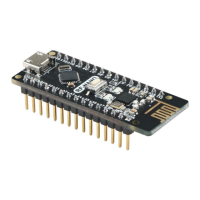Copy right © 2018 Shenzhen Emakefun Technology co., Ltd.
EEPROM :1KB (ATmega328)
CH340 USB to serial port chip
Clock 16 MHz
1.2.1 Power Supply
Arduino Nano power supply mode: mini-B USB interface power supply and external vin connection
7~12V external DC power supply
1.2.2 Memory
ATmega328 includes on-chip 32KB Flash, of which 2KB is used for Bootloader. There are also 2KB
SRAM and 1KB EEPROM.
1.2.3 Input and Output
14 digital input and output ports: The working voltage is 5V, and each channel can output and access
the maximum current of 40mA. Each channel is equipped with a 20-50K ohm internal pull-up resistance
(not connected by default). In addition, some pins have specific functions.
Serial signal RX (0), TX (1): It provides serial port receiving signal with TTL voltage level, connected
to the corresponding pin of FT232Rl.
External Interrupt (No. 2 and No. 3): Trigger interrupt pin, which can be set to rising edge, falling edge
or simultaneous trigger.
Pulse Width Modulation PWM (3, 5, 6, 9, 10, 11): Provides 6 channel, 8-bit PWM outputs.
SPI(10(SS),11(MOSI),12(MISO),13(SCK):SPI Communication Interface.
LED (No. 13): Arduino is specially used to test the reserved interface of the LED. When the output is
high, the LED is lit. When the output is low, the LED is off.
6 analog inputs A0 to A5: Each channel has a resolution of 10 bits (that is, the input has 1024 different
values), the default input signal range is 0 to 5V, and the input upper limit can be adjusted by AREF. In
addition, some pins have specific functions.
TWI interface (SDA A4 and SCL A5): Supports communication interface (compatible with I2C bus).
AREF: The reference voltage of the analog input signal.
Reset:The microcontroller chip is reset when the signal is low.
1.2.4 Communication Interface
Serial port: The built-in UART of ATmega328 can communicate with external serial port through digital
port 0 (RX) and 1 (TX).

